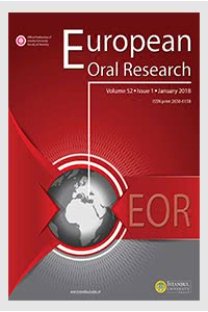AMALGAM RESTORASYONLARIN FARKLI BAĞLAYICI AJAN VE MATERYALLER İLE ONARIMININ KENAR UYUMU AÇISINDAN MİKROSIZINTI YÖNTEMİ İLE İNCELENMESİ
Tamir, amalgam bağlayıcı ajan, mikrosızıntı, Ormocer
___
- Sharif MO, Merry A, Catleugh M , Tickle M , Brunton P, Dunne SM, Aggarwal VR. Replacement versus repair of defective restorations in adults: amalgam. Cochrane Database Syst Rev, 2010; 17: 2-3.
- Kamann WK, Gangler P. Filling repair Aracılığıyla, Aynı ya da Farklı Materyalle
- Onarımı ve Sonuçlarının Tutuculuk Açısından and repair fillings. Schweiz Monatsschr Zah- nmed, 2000; 110: 1054-71.
- Blum I R Hafiana K, Curtis A, Barbour ME, Attin T, Lynch CD, Jagger DC. The effect of surface conditioning on the bond strength of resin composite to amalgam. J Dent, 2012; 40: 15-21.
- 4. Hickel R, Manhart J. Longevity of Res, 1997; 76: 1104. restorations in posterior teeth and reasons for failure. J Adhes Dent, 2001; 3: 45-64.
- Moncada G, Fernandez E, Martin J, Arancibia C, Mjör I , Gordan VV. Increas ing the longevity of restorations by minimal intervention: a two-year clinical trial. Oper microleakage study. J Esthet Dent, 1992; 4: Dent, 2008; 33: 258-64. 44-47.
- Mjör IA. Placament and replacement of restorations. Oper Dent, 1981; 6: 49-54.
- Mjör IA. Repair versus replacement of failed restorations. Int Dent J, 1993; 43: 466-72.
- Mjör IA, Jokstad A, Qvist V. Longevity of posterior restorations. Int Dent J, 2001; 40: 11-17.
- Mjor IA, Qvist V. Marginal failures of amalgam and composite restorations. J Dent, 1997 Jan; 25: 25-30.
- Deligeorgi V, Mjor IA, Wilson NH. An overview of reasons for the placement and replacement of restorations. Prim Dent Care, 2001; 8: 5-11.
- Tobi H, Kreulen CM, Vondeling H, van Amerongen WE. Cost-effectiveness of composite resins and amalgam in the re placement of amalgam Class I I restorations. Community Dent Oral Epidemiol, 1999; 27: 137-43. MG. Effect of amalgambond on flexural bond strength of amalgam. J Dent Res, 1991; 70: 300.
- Dörter C. Amalgam Dolgularda Oluşan Defektlerin Farklı Bonding Ajanlar Karşılaştırmalı Olarak Değerlendirilmesi. Doktora Tezi, LÜ Dişhekimliği Fakültesi Diş Hastalıkları ve Tedavisi Ana Bilim Dalı Konsevatif Diş Tedavisi Bilim Dalı, 1994.
- Dörter C, Koray F, Duman İ Amal gam repair with dentin adhesives. J Dent
- Dörter C, Koray F, Duman İ Flexural bond strength of amalgam repair. J Dent Res 1998; 77: 1227.
- Leelawat C, Scherer W,Chang J. Addi- tons of fresh amalgam to existing amalgam:
- Leelawat C, Scherer W, Chang J. Ad dition of fresh amalgam to existing amal gam utilizing various adhesive liners: a SEM study. J Esthet Dent, 1992; 4: 50-53.
- Özer F, Ünlü N, Sengün A, Öztürk B. Amalgam repair: evaluation of bond strength and Microleakage. Oper Dent, 2002; 27: 199-203.
- Helvatjoglou-Antoniades M , Pahini ST, Karesiz A. Microleakage o f bonded amalgam restorations: effect of thermal cy cling. Oper Dent, 2000; 25: 316-23.
- Chang JC, Chan JT, Chedda A, Igleı sias A. Mikroleakge of amalgam restorations rial, 1992; 8: 370-74. with 4-META bonding agents. J Dent Res, 1993; 72: 223.
- Mahler DB. Effect of dimensional change of the amalgam on amalgam bondı ing. Jour Dent Res, 2001; 80: 42.
- Meiers JC, Turner D. Microleakage of dentin/amalgam alloy bonding agents: results after 1 year. Oper Dent 1998; 23: 16-23.
- Estafan D, Estafan A. Millhouse D. MG. Effect of amalgambond on flexural
- bond strength of amalgam. J Dent Res, 1991; Cavity wall adaptation of resin based comı posites lined with flowable composites. Am J Dent, 2000; 13: 192-94.
- Yazıcı AR, Özgünaltay G, Dayangaç B. The effect of different types of flowable thermocycling on the reinforcing ability of restorative resins on microleakage of classV cavities. Oper Dent, 2003; 28: 773-78.
- Gitte-HaBhoff K. Tooth-composite mesio-occlusodistal amalgam restorations. ınterface from specific and nonspecific adı hesive restoravite system. J Biomed Mater Re Part, 2004; 71: 38-45.
- Giannini M , P a u l l i l l o to amalgam and resin composite bonded
- to amalgam. Quintesssence Int, 1998; 29: LAMS,Ambrosano GMB. Effect of surface roughness on amalgam repair using adhesive systems. Brazil Dent, 2002; 13: 179-83.
- Nakabayashi N.Bonding of restoraı tive materials to dentine: the present status in Japan. Int Dent J, 1985; 35: 145-54.
- Nakabayashi N . Adhesive bonding with 4-META. Oper Dent, 1992; 5: 125-30.
- Deligeorgi V, Mjor IA, Wilson NH. An overview of reasons for the placement 245-50. and replacement of restorations. Prim Dent Care, 2001; 8: 5-11.
- Charton DG, Moore BK. Invitro evaluation of the use of resin liners tore- duce mikroleakage and improve retention of amalgam restorations. Oper Dent, 1992; ation and marginal microleakage of amal 17: 112-19.
- Swift EJ, Triolo M.Shear bond 651-56.
- Yu S. The effect of water storage on dentin bond strength of 8 bonding agents. J Dent Res 1999; 78: 87.
- ISSN: 2630-6158
- Yayın Aralığı: Yılda 3 Sayı
- Başlangıç: 1967
- Yayıncı: İstanbul Üniversitesi
ZİHİNSEL ENGELLİ ÇOCUKLARDA DAVRANIŞ YÖNETİMİ VE TEDAVİ YAKLAŞIMLARI
Arzu ERDEM, Arzu Pınar ERDEM, Elif YAMAN, Elif YAMAN, Elif SEPET, Elif SEPET, Zeynep AYTEPE
BAŞ-BOYUN KANSERLERİNDE TEDAVİ ÖNCESİ DENTAL GİRİŞİMLER
Kıvanç BEKTAŞ KAYHAN, Kıvanç BEKTAŞ KAYHAN, Meltem ÖZDEMİR-KARATAŞ, Meltem ÖZDEMİR KARATAŞ, Meral ÜNÜR, Yaren KESKİN, Yaren KESKİN, Musa ALTUN, Musa ALTUN, Özlem BAYRAK, Oktay YAZICIOĞLU, Oktay YAZICIOĞLU
AĞIZ GARGARALARININ RESTORATİF MATERYALLERİN RENK STABİLİTESİNE OLAN ETKİSİ
Değer ÖNGÜL, Alpar MİM, Hanife ŞAHİN, Sabire DEĞER
DENTİN HASSASİYETİ VE TEDAVİSİ
Benin SEZGİN, Benin SEZGİN, Berna TARIM
Batu YAMAN, Batu Can YAMAN, Fatma KORAY
DİŞ HEKİMLİĞİNDE DOKU MÜHENDİSLİĞİNİN YERİ
Z. SIRIK, Selen ERGİN, Gülbahar IŞIK
DÜŞÜK DOĞUM AĞIRLIKLI VE ERKEN DOĞAN ÇOCUKLARDA AĞIZ DİŞ SAĞLIĞI
Melis ARAZ, Yeliz GÜVEN, Oya AKTÖREN, Oya AKTÖREN
YAŞLANMANIN ÇİĞNEME SİSTEMİNE ETKİLERİ
Erinç ÖNEM, E. TUĞSEL, E.zuhal TUĞSEL
ORAL İMPLANTOLOJİDE ESTETİK PROBLEMLERİN SERT ve YUMUŞAK DOKU GREFTLERİYLE ÇÖZÜLMESİ
Nevin BÜYÜKAKYÜZ, Nevin BÜYÜKAKYÜZ, Murat ÖZTÜRK
İMPLANT DESTEKLİ PROTEZLER, KOMPLİKASYONLAR VE İMPLANT KAYIPLARI: 24 AYLIK KLİNİK SONUÇLAR
Hakan BİLHAN, Hakan BİLHAN, Canan BURAL, Altuğ ÇİLİNGİR, Altuğ ÇİLİNGİR, Onur GEÇKİLİ, Onur GEÇKİLİ
